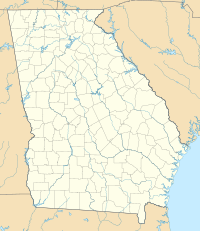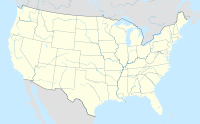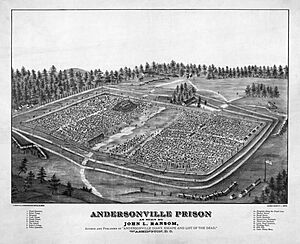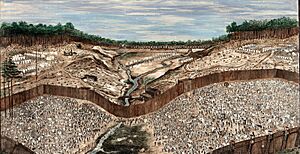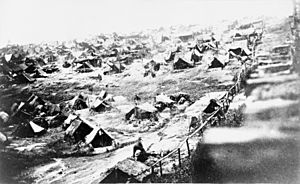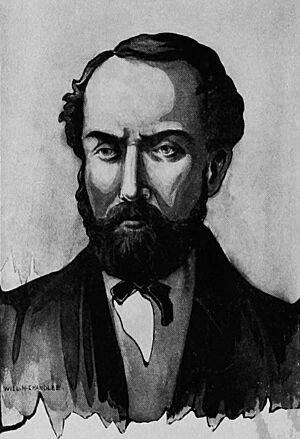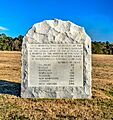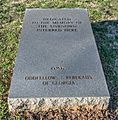Andersonville Prison facts for kids
|
Andersonville National Historic Site
|
|
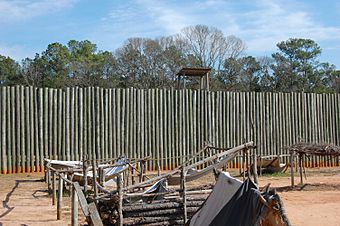
Reconstruction of a section of the stockade wall
|
|
| Location | Macon / Sumter counties, Georgia, United States |
|---|---|
| Nearest city | Andersonville, Georgia, Americus, Georgia |
| Area | 514 acres (208 ha) |
| Visitation | 1,436,759 (2011) |
| Website | Andersonville National Historic Site |
| NRHP reference No. | 70000070 |
Quick facts for kids Significant dates |
|
| Added to NRHP | October 16, 1970 |
| Designated NHS | October 16, 1970 |
The Andersonville National Historic Site is a special place near Andersonville, Georgia. It helps us remember Andersonville Prison, also called Camp Sumter. This was a prison camp for soldiers during the last 14 months of the American Civil War.
Most of this historic site is in Macon County. It includes the Andersonville National Cemetery and the National Prisoner of War Museum. The prison itself was built in February 1864 and closed in April 1865.
Captain Henry Wirz was in charge of the prison. After the war, he was put on trial and executed for serious wrongdoings. The prison was very crowded, holding four times more people than it was built for. There wasn't enough water or food, and the conditions were very dirty.
About 45,000 Union soldiers were held at Camp Sumter. Nearly 13,000 of them, about 28%, died there. The main reasons for death were diseases like scurvy, diarrhea, and dysentery.
Contents
Life Inside Andersonville Prison
The prison opened in February 1864. It first covered about 16.5 acres (6.7 ha) of land. A 15-foot (4.6 m) high wooden fence, called a stockade, surrounded it. In June 1864, the prison was made larger, growing to 26.5 acres (10.7 ha).
The stockade was shaped like a rectangle. It measured about 1,620 feet (490 m) long and 779 feet (237 m) wide. There were two entrances on the west side. Each prisoner had only a small space, about 5 feet by 6 feet (1.5 x 2 m), to live in.
What Prisoners Saw
Robert H. Kellogg was a sergeant major in the 16th Regiment Connecticut Volunteers. He described entering the prison on May 2, 1864:
"When we entered, we saw a sight that shocked us. Men who were once strong were now just walking skeletons. They were covered in dirt and bugs. Many of our men wondered if this was hell. They prayed for God to protect them. In the middle of the camp was a swamp. Prisoners used this marshy area as a toilet. The smell was terrible. Our group's spot was near this awful place. We worried about how we would survive the summer there."
Other prisoners, like Ransom Chadwick and John L. Ransom, also wrote about their experiences. Father Peter Whelan arrived in June 1864. He worked to bring help and supplies to the prisoners.
The Dead Line
Inside Andersonville, there was a special fence called "the dead line." It was about 19 ft (5.8 m) away from the main stockade wall. This line kept prisoners from getting too close to the wall. The wall was made of tall, rough logs, about 16 ft (4.9 m) high.
If a prisoner crossed or even touched the dead line, guards would shoot them without warning. These guards stood in watchtowers called "pigeon roosts." Some people think the modern term "deadline" (meaning a time limit) might come from this prison's dead line.
Health Challenges
During the war, Andersonville Prison often did not have enough food. By 1864, everyone in the Confederacy, including soldiers and civilians, struggled to find enough to eat. Prisoners received even less food than the guards.
The prisoners suffered from very poor diets. They did not get enough fresh fruits and vegetables. This led to diseases like scurvy, caused by a lack of vitamin C. Dysentery and typhoid fever were also common. These diseases spread easily because of the dirty living conditions. The only drinking water came from a creek that also served as the camp's toilet. It was full of waste from thousands of sick men. Even when food was available, it was often bad quality and poorly prepared.
Prisoners did not get new clothes. Their own clothes often fell apart. Sometimes, clothes were taken from dead prisoners. One prisoner, John McElroy, remembered fights over clothes from those who had just died.
Even though the prison was surrounded by forests, prisoners got very little wood. They needed wood for warmth and cooking. Without wood or cooking tools, it was hard to prepare the small amounts of cornflour they received. Many prisoners died from hunger, cold, and disease. They were buried in large graves.
A doctor named Joseph Jones investigated the high death rate in 1864. He found that a disease called "scorbutic dysentery" was a major cause. This was bloody diarrhea caused by not having enough vitamin C. More recently, in 2010, a historian suggested that hookworm disease, which wasn't known during the Civil War, also caused many deaths.
How Prisoners Survived
During the Civil War, prison camps were a new idea. In 1863, President Lincoln set rules for how prisoners should be treated. These rules said prisoners should get food and medical care. They also protected prisoners from harm. Andersonville did not follow these rules.
Life in Andersonville was very difficult. Prisoners often had to rely on each other to survive. Having friends in the prison made it more likely for a prisoner to live. Friends could share food, clothes, and shelter. They also offered support and protection from other prisoners. Studies show that strong friendships, especially with people from the same background, helped prisoners survive.
The Raiders and Regulators
Some prisoners formed a group called the "Andersonville Raiders." They attacked other inmates to steal food, jewelry, money, and clothes. They used clubs and sometimes killed people to get what they wanted.
Another group, called the "Regulators," formed to stop the Raiders. Peter "Big Pete" Aubrey led them. The Regulators caught most of the Raiders. They held a trial with a judge and jury. The guilty Raiders received punishments like running a gauntlet (being forced to run between two rows of people who hit them), being put in stocks, or wearing a ball and chain. Six of the Raiders were even hanged.
Asking for Help
The conditions were so bad that in July 1864, Captain Henry Wirz let five Union soldiers go. They carried a letter signed by most prisoners. The letter asked the Union to restart prisoner exchanges. This would help reduce the overcrowding and let prisoners leave the terrible camp. The Union said no to this request. The five soldiers, who had promised to return, went back to tell their comrades the bad news.
Many Deaths
About 45,000 prisoners were held at Andersonville. Nearly 13,000 of them died. Historians still discuss why so many died. Some believe it was due to Confederate policies. Others say it was because of severe overcrowding, food shortages, and poor management. The breakdown of prisoner exchanges also played a role.
Diseases were the main cause of death in both armies during the war. Poor sanitation in all camps, including prisons, made infectious diseases a constant problem.
Dorence Atwater's Secret List
A young Union prisoner named Dorence Atwater was chosen to record the names of the dead at Andersonville. This list was for both the Confederacy and the U.S. government. Atwater believed the U.S. government would never see the official list. So, he secretly kept his own list of the dead.
When Atwater was released, he hid his list and took it with him. He was not caught. Later, the New York Tribune newspaper published his list. This happened after the government refused to accept Atwater's list and treated him badly. Atwater thought Captain Wirz wanted to make sure Union prisoners would be too weak to fight again if they survived.
Newell Burch's Diary
Another prisoner, Newell Burch, also wrote about the terrible conditions in his diary. He was captured at the Battle of Gettysburg. He was held at other prisons before Andersonville. Burch was a prisoner for 661 days, making him one of the longest-held Union prisoners of war. His diary is now kept safe in a historical society.
Prisoner Numbers
| Date | Population |
|---|---|
| April 1, 1864 | 7,163 |
| May 5, 1864 | 12,002 |
| June 13, 1864 | 20,654 |
| June 19, 1864 | 23,944 |
| July 18, 1864 | 29,078 |
| July 31, 1864 | 31,680 |
| August 31, 1864 | 31,695 |
Escaping the Prison
Many prisoners tried to escape from Andersonville. Most groups tried to dig tunnels out of the camp. They aimed for nearby forests, about fifty feet from the wall. However, even if they got out, escaping was very hard because the prisoners were so sick and weak.
Prisoners caught trying to escape faced harsh punishments. They could lose their food, be put in chains, or even be killed. Some prisoners tried to "play dead" to escape. Since about a hundred prisoners died each day, guards were not always careful when moving bodies. Prisoners would pretend to be dead and be carried out with the real bodies. At night, they would get up and run away. When Captain Wirz found out about this, he ordered doctors to check all bodies leaving the camp.
Confederate records show that 351 prisoners escaped. Many of them were caught again. The U.S. Army recorded 32 prisoners who made it back to Union lines. Others might have gone home without telling the military, or they might have died.
Moving Prisoners
In the summer of 1864, the Confederacy offered to release prisoners if the Union sent ships to pick them up. Andersonville was inland, so prisoners could only be moved by train and road.
After the Battle of Atlanta in the autumn of 1864, many prisoners who were well enough were moved. They went to other camps like Florence Stockade in South Carolina and Camp Lawton in Georgia. At Camp Lawton, conditions were better. Prisoners were taken by train to the port of Savannah. But when General William Tecumseh Sherman began his "march to the sea" and destroyed Camp Lawton, the remaining prisoners were sent back to Andersonville.
The Prison is Freed
The Union Army freed Andersonville Prison in May 1865. The soldiers found the prisoners looking like "human skeletons" in a terrible, ruined place.
The Trial of Captain Wirz
After the war, Captain Henry Wirz, who was in charge of the prison, was put on trial. He was accused of serious wrongdoings during the war. Union General Lew Wallace led the trial.
Many former prisoners spoke at the trial. They described the awful conditions and accused Wirz of being cruel. The court also looked at official letters from Confederate records. A very important letter was from James Jones, a doctor sent by Richmond to check on the prison in 1864. Jones was horrified by what he saw. He reported that he felt sick after only an hour in the camp. His detailed report helped the prosecution's case.
Wirz argued that he had asked Confederate leaders for more food and tried to make things better for the prisoners. But he was found guilty and sentenced to death. He was hanged on November 10, 1865. Wirz was the only Confederate official executed for war crimes after the war. The terrible suffering of the prisoners at Andersonville greatly affected how people in the North felt about the South after the Civil War.
What Happened Later
In 1890, a group called the Grand Army of the Republic (GAR) bought the land where Andersonville Prison stood. They later gave it to the Woman's Relief Corps (WRC) in 1896. The women accepted this important task. They worked to make the grounds beautiful and create a park.
They bought more land and built a house for a caretaker. They planted grass, fruit trees, and a rose garden with bushes from many states. Several states were given land to build monuments to their soldiers who died there. These states included Massachusetts, Ohio, Michigan, Rhode Island, and Wisconsin. The WRC also built a monument to Lizabeth A. Turner, who led their efforts.
In 1910, the WRC gave the site to the U.S. government. A year later, a special tablet was revealed. It listed the names of the WRC members who helped save and care for the site.
National Prisoner of War Museum
The National Prisoner of War Museum opened in 1998. It is a memorial to all American prisoners of war. The museum uses art, photos, and videos to show what it was like for American prisoners of war in different conflicts. It shows how they were captured, their living conditions, and the hardships they faced. This museum also serves as the park's visitor center.
Andersonville National Cemetery
The cemetery is where the Union prisoners who died at Camp Sumter/Andersonville are buried. This burial ground became a national cemetery. It has 13,714 graves. Of these, 921 graves are for unknown soldiers.
As a National Cemetery, it is also a burial place for more recent veterans and their families.
Visitors can walk around the 26.5-acre (10.7 ha) site of Camp Sumter. White posts mark the prison's original outline. Two parts of the stockade wall have been rebuilt: the north gate and a corner.
Stories and Films
- Andersonville (1955) is a novel by MacKinlay Kantor about the prison. It won a special award called the Pulitzer Prize for Fiction.
- The Andersonville Trial (1970) was a TV show based on a play. It showed the trial of Captain Henry Wirz in 1865.
- The TV movie Andersonville (1996), directed by John Frankenheimer, tells the story of the prison camp.
Images for kids
Monuments to Remember
Learn More
- American Civil War prison camps
- Camp Douglas
- Elmira Prison
- Florence Stockade
- Libby Prison
- Camp Lawton
See also
 In Spanish: Sitio Histórico Nacional de Andersonville para niños
In Spanish: Sitio Histórico Nacional de Andersonville para niños


